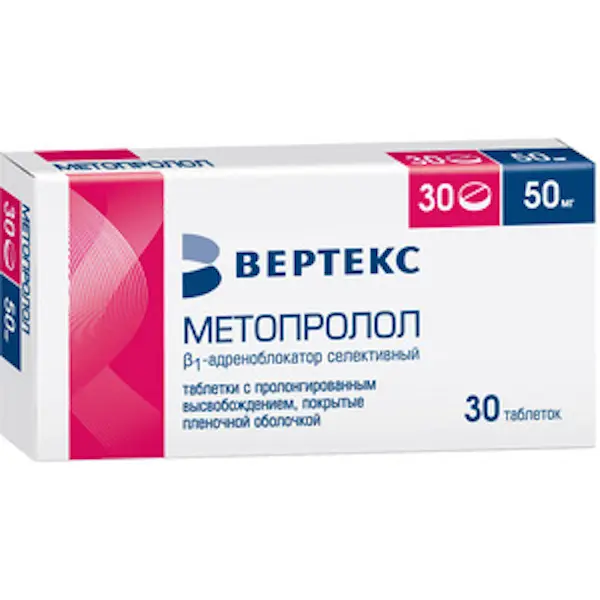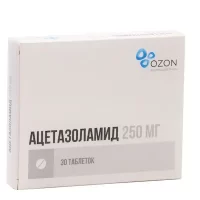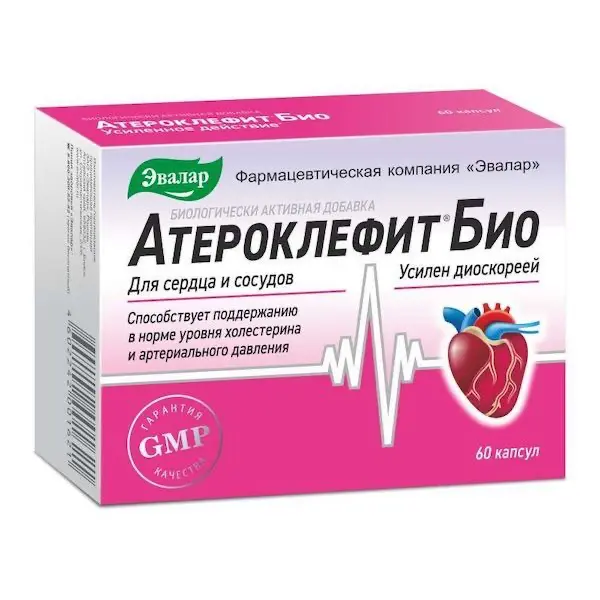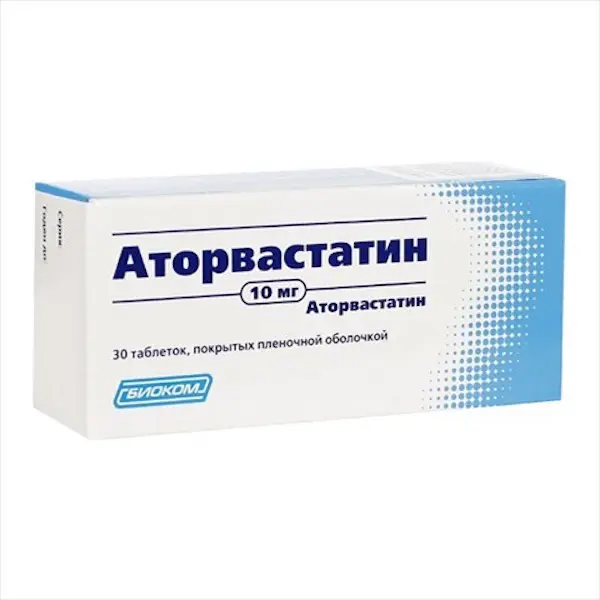Description
Metoprolol-Vertex Pharmacodynamics
Metoprolol is a ?1-adrenoblocker that blocks the ?1-receptors at doses significantly lower than those required to block the ?2-receptors.
Metoprolol has a minor membrane-stabilizing effect and has no partial agonist activity.
Metoprololol reduces or inhibits the agonist effect that catecholamines, released during nervous and physical stress, have on cardiac activity. This means that metoprolol has the ability to inhibit the increase in heart rate (HR), minute volume, and cardiac contractility, as well as the increase in blood pressure (BP) caused by the sudden release of catecholamines.
In contrast to conventional tablet dosage forms of selective
?1-adrenoblockers (including metoprolol tartrate) in tablet form, there is a constant plasma concentration of metoprolol and a sustained clinical effect (?1-blockade) for more than 24 hours.
Due to the absence of obvious peak plasma concentrations, clinically metoprolol is characterized by better ?1-selectivity than conventional tablet forms of ?1-adrenoblockers. In addition, the potential risk of side effects observed at peak plasma concentrations of metoprolol, such as bradycardia and weakness in the legs when walking, is greatly reduced.
In patients with symptoms of obstructive pulmonary disease, metoprolol may be administered in combination with ?2-adrenomimetics, if necessary. When used in combination with ?2-adrenomimetics, metoprolol at therapeutic doses has less effect on bronchodilation induced by ?1-adrenomimetics than non-selective ?-adrenoblockers.
Metoprolol affects insulin production and carbohydrate metabolism to a lesser extent than non-selective ?-adrenoblockers. The effect of metoprolol on the response of the cardiovascular system in hypoglycemia is significantly less pronounced compared to nonselective ?-adrenoblockers.
The use of metoprolol in arterial hypertension leads to a significant reduction of BP for more than 24 hours, both in “lying” and “standing” position, as well as on load. At the beginning of metoprolol therapy, there is an increase in vascular resistance. However, with prolonged use, BP may decrease due to a decrease in vascular resistance while cardiac output remains unchanged.
In the MERIT-HF study (NYHA class II-IV chronic heart failure survival study with reduced cardiac output fraction (? 0.40) including 3991 patients) metoprololol showed improved survival and reduced hospitalization rate. With long-term treatment, patients achieved an overall improvement in symptoms (according to NYHA grades). Also, therapy with metoprolol showed increased left ventricular ejection fraction and decreased left ventricular end-systolic and end-diastolic volumes.
Quality of life, during treatment with metoprololol, did not deteriorate or improved. Improved quality of life, with treatment with metoprolol, was observed in patients after myocardial infarction.
Indications
– arterial hypertension;
– angina pectoris;
– stable symptomatic chronic heart failure with impaired left ventricular systolic function (as adjunctive therapy to the main treatment of chronic heart failure);
– reduction of mortality and recurrent infarction rate after the acute phase of myocardial infarction;
– cardiac rhythm disorders, including supraventricular tachycardia, reduced rate of ventricular contractions in atrial fibrillation and ventricular extrasystoles;
– functional disorders of cardiac activity, accompanied by tachycardia;
– Prevention of migraine attacks.
Contraindications
– arterial hypertension;
– angina pectoris;
– stable symptomatic chronic heart failure with impaired left ventricular systolic function (as adjunctive therapy to the main treatment of chronic heart failure);
– reduction of mortality and recurrent infarction rate after the acute phase of myocardial infarction;
– cardiac rhythm disorders, including supraventricular tachycardia, reduced rate of ventricular contractions in atrial fibrillation and ventricular extrasystoles;
– functional disorders of cardiac activity, accompanied by tachycardia;
– Prevention of migraine attacks.
– Atrioventricular block of II and III degree;
– Heart failure in decompensation;
– Permanent or intermittent therapy with inotropic agents acting on the ?-adrenoreceptors;
– clinically significant sinus bradycardia;
– sinus node weakness syndrome;
– cardiogenic shock;
– severe peripheral circulatory disorders, including the threat of gangrene;
– Arterial hypotension (systolic BP less than 100 mm Hg);
– suspected acute myocardial infarction with heart rate less than 45 beats per minute, PQ interval on electrocardiogram (ECG) greater than 0.24 seconds, or systolic BP less than 100 mm Hg;
– known hypersensitivity to metoprolol, any other drug components or other ?-adrenoblockers;
– co-administration with “slow” calcium channel blockers such as verapamil, for intravenous administration;
– Under 18 years of age (efficacy and safety have not been established);
– pheochromocytoma (without concomitant use of ?-adrenoblockers);
– period of breastfeeding.
Dosage and administration
- Metoprolol is intended for daily administration once a day, it is recommended to take the drug in the morning. Metoprolol tablet should be swallowed with liquid. The tablets should not be chewed or crumbled. Food intake does not affect the bioavailability of the drug.
- When adjusting the dose, the development of bradycardia should be avoided.
- Arterial hypertension
50-100 mg once a day. If necessary, the dose can be increased up to 200 mg per day or another hypotensive agent can be added, preferably a diuretic and a dihydropyridine calcium antagonist. - Angina
100-200 mg once daily. If necessary, another antianginal drug may be added to therapy. - Stable symptomatic chronic heart failure with impaired left ventricular systolic function
Patients must be in stable chronic heart failure without an episode of exacerbation within the past 6 weeks and without changes in underlying therapy within the past 2 weeks. - Therapy of chronic heart failure with ?-adrenoblockers may sometimes lead to a temporary worsening of the symptomatic picture. In some cases it is possible to continue the therapy or reduce the dose, in some cases it may be necessary to cancel the drug.
- Stable chronic heart failure, NYHA functional class II
Metoprolol can be administered in other dosage form to meet the following requirements: prolonged release film-coated tablets of 25 mg or sustained release film-coated tablets of 50 mg with a slash (other manufacturer). - The recommended starting dose of metoprolol in the first 2 weeks is 25 mg once daily. After two weeks of therapy, the dose may be increased to 50 mg once daily and may be doubled every 2 weeks thereafter.
The maintenance dose for long-term treatment is 200 mg once daily. - Stable chronic heart failure, NYHA functional class III-IV
Other dosage form of metoprolol may be used as follows: prolonged release film-coated tablets, 25 mg with a slash. - Recommended starting dose for first 2 weeks is 12.5 mg (half of 25 mg tablet) metoprolol once daily. The dose is adjusted individually. During the period of increasing the dose, the patient should be monitored as some patients may have worsening heart failure symptoms.
- After 1-2 weeks, the dose may be increased to 25 mg metoprolol once daily. Then, after two weeks, the dose may be increased to 50 mg once daily. In patients who tolerate the drug well, the dose may be doubled every 2 weeks until a maximum dose of 200 mg metoprolol once daily is reached.
- In case of arterial hypotension and/or bradycardia, it may be necessary to reduce the concomitant therapy or reduce the drug dose. Arterial hypotension at the beginning of therapy does not necessarily indicate that this dose of the drug will not be tolerated during further long-term treatment. However, the dose should not be increased until the condition has stabilized. Renal function may need to be monitored.
- Cardiac rhythm disorders.
100-200 mg once daily. - Maintenance treatment after myocardial infarction
200 mg once daily. - Functional disorders of cardiac activity accompanied by tachycardia
100 mg once daily. If necessary, the dose may be increased to 200 mg per day. - Prevention of migraine attacks
100-200 mg once daily. - Patients with impaired renal function
There is no need to adjust the dose in patients with impaired renal function. - Patients with impaired liver function
Taking into account the low degree of binding to blood plasma proteins, no dose adjustment is required. However, in patients with severe hepatic impairment (patients with severe cirrhosis or portocaval anastomosis) a dose reduction may be required.





